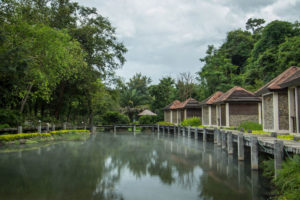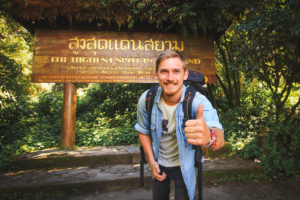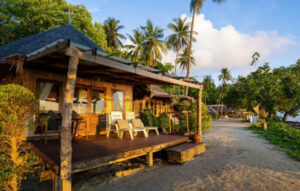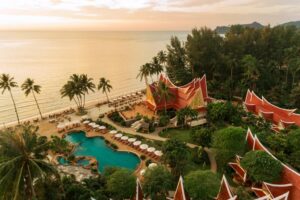Share This Article!
The Ultimate List of Things to do in Chiang Rai
There are so many things to do in Chiang Rai that you could easily spend an entire week exploring this far northern end of Thailand.
Most visitors only spend a day or two in Chiang Rai, quickly rushing around to see the White Temple, the Black House, and the Clocktower. They then head off back to Chiang Mai and don’t realise how much was missed!
Stay a little longer and you will quickly learn that Chiang Rai is actually filled with stunning waterfalls, scenic mountain viewpoints, authentic minority villages and a unique Lanna food scene.
In fact the culture up here is like nowhere else I have experienced in Thailand!
I spent over 6 months living in Chiang Rai exploring every aspect of the province.
In this time showered in the jungle under a 70 metre tall waterfall, watched the sun rise over the Laotian countryside, and relaxed in my fair share of hot springs. I met real ethnic villagers, rode crazy motorbike trails, and became friends with local artists.
Now I want to share all of this with you. All I ask is that you share this article too!
What's in this Chiang Rai Guide
Where is Chiang Rai?
Chiang Rai is the northernmost province of Thailand. It is about 2 hours north of Chiang Mai (which I have also written an in-depth guide on).
The province of Chiang Rai shares borders with Laos and Myanmar. All three countries meet together at the point known as The Golden Triangle. The name Chiang Rai refers to the province, while Muang Chiang Rai is the largest town in the province.
To help you plan your trip I have pinned all the destinations in this article on the interactive Chiang Rai map below. Click on an icon for further information and the exact location of each destination. Feel free to share this with other travelers too.
Also Read: My In-Depth Guide to Chiang Mai
How to Get to Chiang Rai
Chiang Mai to Chiang Rai – the best way to get from Chiang Mai to Chiang Rai is the Green Bus (tickets and timetable). Tickets start from 129 THB per person. A one-way journey takes about 3 hours.
Chiang Rai to Luang Prabang – the slow boat from Luang Prabang to Chiang Rai is a popular route for travelers heading from Thailand to Laos or vice versa. The slow boat departs from Huay Xai, a small border town 65 kilometers away.
Flights to Chiang Rai – Chaing Rai has a domestic terminal with daily flights from major airports including Bangkok, Phuket and Chiang Mai. Popular budget airlines are AirAsia Thailand, Nok Scoot, and Thai Smile.
Train to Chiang Rai – there is no train to Chaing Rai, however, you can take a 14 hour train from Bangkok to Chiang Mai (tickets and timetables), followed by the Green Bus from Chiang Mai to Chiang Rai.
How Long Should I Stay in Chiang Rai?
To see Chiang Rai thoroughly I recommend staying for 5 days. This will allow you to make day trips up the mountains and visit some ethnic hill tribes. You will have the flexibility to visit almost all the destinations in this guide.
If your schedule is tight, visit Chiang Rai for 3 days. This is enough time to explore the town and make a day trip to a waterfall and up the mountains. With the right planning, you can quickly fit in 4 to 5 of the destinations in this article.
With just one day in Chiang Rai, you can visit a few local attractions detailed in the next section. Many people visit Chiang Rai as a one day trip from Chiang Mai. While I don’t recommend this, you will still get a nice intro to the town.
Whether you have one day or one week, my detailed Chiang Rai travel guide will help you plan your trip, making sure you get the most out of your time.
Attractions in Chiang Rai (Around Town)
Let’s start with the easy destinations first. There are plenty of attractions around town like temples and markets which are perfect if you only have one day in Chiang Rai.
The most popular places to start are the White Temple, Black House, and the Blue Temple all of which I have covered further down in this article on the section of temples.
The following five destinations are all actually within walking distance of Chiang Rai’s town center.
Chiang Rai Walking Street
The most lively attractions in Chiang Rai are the Saturday and Sunday night walking streets. Chiang Rai’s walking streets are much like the large open air markets in Chiang Mai.
You will find lots of food, clothing, souvenirs, and artworks. You will also find live music and bars where you can hang out at night and meet many other travelers.
The Saturday night walking street is located on Thanalai Road, and is open from 5pm to just after midnight. The Sunday night walking street is located just behind Chaing Rai hospital, and is open from 5pm to about 11pm.
Can’t decide which walking street to visit? Just do both! Both night markets are lots of fun and a little different than each other.
Chiang Rai Clocktower
The Chiang Rai Clocktower is a popular monument, artwork, and landmark right in the center of town. Locals often talk about other destinations in being so many meters or minutes away from the clocktower. So when you’re lost you can always end up back here.
The clocktower is the world’s most ornate round-a-bout in the world. It was designed by Chalermchai Kositpipat (same artist who decorated the White Temple).
The best time to visit the Clocktower is at 7pm, 8pm, and 9pm each night while the 10 minute light and music show plays. Make sure you are there on the hour otherwise you will miss it and need to wait for another hour.
The Chiang Rai clocktower is located right in the middle of town at the intersection of Thanon Jet Yot and Thanon Baanpa Pragarn.
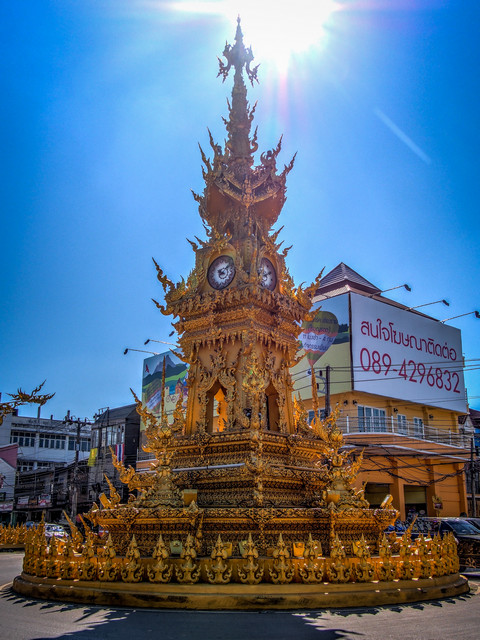
King Mengrai Monument
The King Mengrai Monument is another popular attraction right near the town center in Chaing Rai, about a 15 minute walk northeast of the clocktower.
This monument is dedicated to King Mengrai who established the Lanna Kingdom of northern Thailand (the ancient kingdom of Chiang Rai and Chaing Mai) back in 1296. It is an easy stop if you’re doing a quick walking tour around town.

Chiang Rai Night Bazaar
The Chiang Rai Night Bazaar is a good night time hang out spot for food, cold beer, and live shows. Some nights there is live music, other nights there may be live theatre or Thai comedy shows. You won’t always understand what’s going on, but it’s entertaining.
The stalls around the Chiang Rai Night Bazaar offer a wide range of handmade goods from the surrounding ethnic villages. You can also find other typical market type goods such as clothing, food, and painting by local artists.
The Chiang Rai Night Bazaar is open daily from 6pm to midnight.
Chiang Rai Beach
Going to the beach may sound odd, but it is actually one of my favourite things to do in Chiang Rai. Chiang Rai beach is located about 4km outside of town along the Kok River. It is a great place for a local lunch in one of these bamboo huts surrounded by the forest.
You can go for a swim in the river which is a refreshing break. Be careful swimming during the rainy season as the current can get dangerously strong. It is fairly safe to swim or tube down the river in the dry season from October to March.
Getting to Chiang Rai beach from town is very easy. A motorbike or songtaew will take about 10 minutes. It is also possible to walk however this could take 45 minutes to an hour.
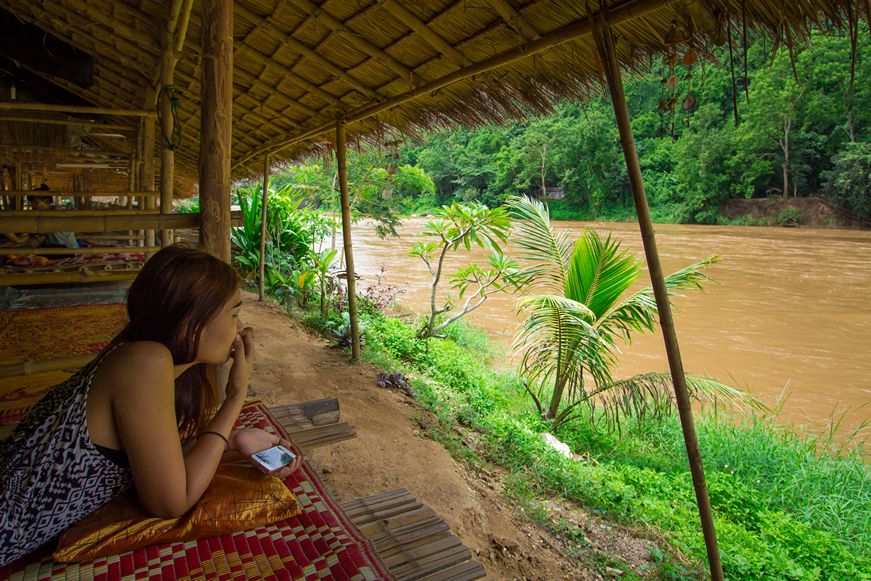
Waterfalls in Chiang Rai
One of my favourite things to do in Chiang Rai is to visit a waterfall. In my opinion, Chiang Rai has the best waterfalls in all of Thailand.
When you hike through the jungle and shower under a huge 70-meter tall waterfall at the end, you will agree.
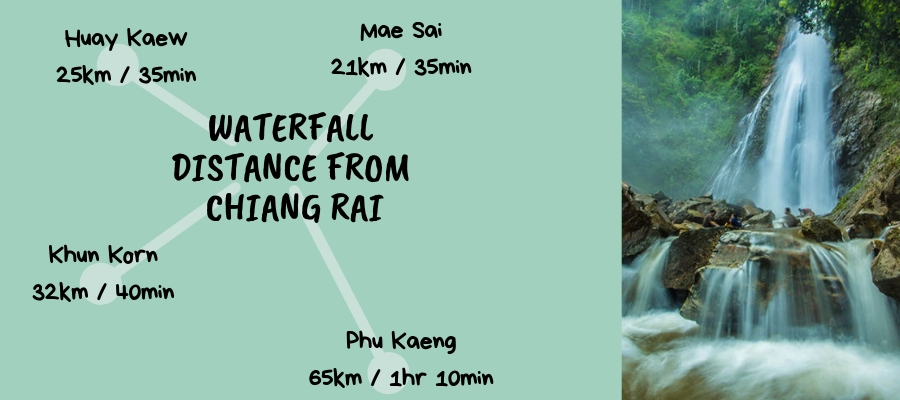
Some waterfalls in Chiang Rai are close to town, others are further away. You can choose which waterfall suits your trip best, or visit them all!
I’ve included a map of all the waterfalls in Chiang Rai and lots of travel planning advice in my Chiang Rai travel guide here, check it out.
Khun Korn Waterfall
Khun Korn Waterfall is the tallest and perhaps the best waterfall in Chiang Rai. It is located in the Namtok Khun Korn Forest Park about 30km east of Chiang Rai.
Most people get here either by motorbike or songtaew from the town centre.
You need to walk a 1.5-kilometre forest trail from the park entrance. You will know when you’re approaching the waterfall as you will hear it! The force of the water is strong, especially during the wet season. I went for a shower and lost my sunglasses, never to be seen again.
Get all the details on how to get to Khun Korn Waterfall and lots more photos in my dedicated blog post.

Huay Mae Sai Waterfall
Huay Mae Sai Waterfall is one of my favourite waterfalls in Chiang Rai. It is so beautiful yet so unknown.
This small two-tiered waterfall is located 19km from the town in the middle of the forest. As there is no public transport here, the best way of getting to Huay Mae Sai waterfall is by motorbike or a private songtaew transfer.
There is a 15-minute walking trail from the parking area to the Huay Mae Sai Waterfall. The trail is slippery when wet so take caution. The first level has a deep pool which is great for swimming. The second level has a taller waterfall and a good place to sunbake.
Huay Mae Sai waterfall is not known to many western tourists and is not offered on tour packages. It is also right near a nice Lahu Ethnic Hill Tribe which you can visit too.
Huay Kaew Waterfall
The Huay Kaew Waterfall is another beautiful two-tiered waterfall, located deep in the forest. Hardly any tourists make it out this far. Those that do come here are generally on hiking tours to the Pha Soet Village and Akha Hill Tribe. Do not confuse this with the Huay Kaew Waterfall in Chiang Mai.
The road to Huay Kaew Waterfall in Chiang Rai is a steep and badly potholed dirt/concrete trail. The route follows the Kok River before heading deep into the forest. Near the end, you will pass tea plantations surrounding the Pha Soet Village and come across a sign for the waterfall. From here it is a bit of walking up the hill, but not far.
I advise only taking your own transport out to the Huay Kaew Waterfall if you are feeling quite adventurous – and seriously have travel insurance. Otherwise, arrange for some private transport.
Combine the Huay Kaew Waterfall, the Pha Soet Akha Village and the Huay Mak Lium Hot Spring for a great day trip from Chiang Rai. If you’re interested send me an email and I’ll personally help you arrange it.
Pu Kaeng Waterfall
Pu Kaeng Waterfall (also spelled Phu Kaeng Waterfall) is one of the best waterfalls in Chiang Rai and all of Thailand. This waterfall consists of 9 levels flowing through the dense jungle. You will hike through the jungle for about 45 minutes from the starting point up to level 9. The trail is slippery, and overgrown as not many people visit. Pu Kaeng Waterfall is a great destination to get out into wild Thailand.
Pu Kaeng waterfall is located about 70km south of Chiang Rai nearby the district of Pan. To get here you Phahonyothin Road south of Chiang Rai towards Chiang Mai. After about an hour you will see the sign for the waterfall on the opposite side of the road.
The best way to get to Pu Kaeng Waterfall is to hire a car or songtaew from Chiang Rai. National park entry fees are 200 THB per person plus a vehicle entry fee.

Pong Phrabat Waterfall
The Pong Phrabat waterfall is located 14km north of Chiang Rai in the Lam Nam Kok National Park. The entrance is at the end of a long road veering off to the mountains behind the Rajabhat University. You will find the National Park HQ at the end of the road. From there it is an easy walk to to the Phong Phrabat Waterfall itself.
This waterfall is only a small cascading stream, nothing like the huge Khun Korn Waterfall. There are a couple of pools deep enough for swimming in, and some grass to lay back an relax in the forest.
The area nearby the National Park HQ is great for a picnic. You may see many locals hanging out here, especially students from the nearby Rajabhat University.
Visit Pong Phrabat Waterfall with the Black House and the Phong Phrabat Hot Spring for an easy day trip. You will easily tick off a few things do in Chiang Rai in one day.
Temples in Chiang Rai
There are 1,011 temples in Chiang Rai, that’s about three times more than in Bangkok!
Some of these temples date back to the early 13th Century in the time of the Lanna Kingdom, while others have been constructed only in recent years.
The most popular temples near town are Wat Rong Khun (the White Temple) and Wat Rong Sua Ten (the Blue Temple) which I’ve detailed below.
White Temple (Wat Rong Khun)
One of the most iconic things to do in Chiang Rai is to visit the White Temple. Read my full article on this amazing work of art.
The art on both the interior and exterior of the White Temple has taken local artist Chalermchai Kositpipat many years to create. In 2014 a huge earthquake shook Chiang Rai and damaged some of the work inside. Chalermchai said it has taken him to long to create his masterpieces and that he would not focus on repairing the damage done. However, before long he was already back inside the temple working on the art again.

Wat Huay Pla Kang
Wat Huay Pla Kang is the newest addition in the list of unique temples in Chiang Rai. The huge statue of Bodhisattva Guan Yin, which is commonly mistaken for a Buddha, is visible from parts of town. Right next to this huge statue there is tall 9 storey pagoda which you can climb to the top of (or take the lift for 40 THB) for a great view looking over Chiang Rai.
Wat Huay Pla Kang is located about 6 kilometers north west of town. There is no public transport here, so you either need to negotiate with a Tuk Tuk driver or take your own motorbike. I suggest visiting Wat Huay Pla Kang on a trip out to Mae Sai Waterfall.

Wat Rong Suea Ten
In Thai Wat Rong Suea Ten translates to the house of the dancing tiger, however, it is commonly referred to by foreigners as the Blue Temple.
From the outside, the temple has similar decorations as Wat Rong Khun (the White Temple). The interior is painted in bright blue with gold detailing. There is a large Buddha statue at the end of the main room making it one of the most photogenic spots in Chiang Rai.
Wat Rong Suea Ten is located about 3 kilometers north of town. It is possible to walk or cycle here. I suggest visiting Wat Rong Suea Ten on a trip to Baan Dam (the Black Hose) and Pong Phrabat Waterfall.

Art Galleries in Chiang Rai
Chiang Rai seems to be the art capital of Thailand. There is a huge range of talented artists living here turning out some amazing artwork from landscape painting to modern sculptures. There are a few great galleries to view both these traditional and contemporary artworks near the town.
Art Bridge Chiang Rai
The Art Bridge gallery is located at the turnoff to Chiang Rai International Airport (Mae Fah Luang Airport) and hosts the works of many local Chiang Rai artists. The collection changes every few months. Expect to find huge panorama paintings of the northern Thailand landscape, modern art and a collection of sculptures.
The Art Bridge gallery is best visited together with a trip to the Black House (Baan Dam).
Black House (Baan Dam)
Many people refer to the Black House as the Black Temple thereby drawing a similarity to the White Temple. The Black House (Baan Dam) is actually not a temple but the house of the creative artist Thawan Duchanee. There are a few buildings to explore in the grounds of the Black House each hosting an odd collection of artifacts.
Hiking Chiang Rai's Mountains
One of my favourite things to do in Chiang Rai’s provincial region is to hike the mountains. The province is surrounded by a stunning mountain range on both the east, bordering Laos, and the west, bordering Myanmar. There are so many scenic viewpoints along the mountains where you can catch an incredible sunrise, like Phu Chi Fa below.
The mountains are the perfect place to do some trekking in Chiang Rai. In these regions, you will also get to visit some of the authentic minority villages from the Karen, Akha, and Hmong ethnicities.
Want to go explore Chiang Rai’s mountains? Learn more in my Chiang Rai travel guide.

Phu Chi Fa
One of Chiang Rai’s most scenic locations lies tucked away in the northeastern corner. The jagged rocky summit of Phu Chi Fa allows you to stand way above the clouds where you can watch the sunrise. Down below in the valley is a small village along the border of Laos.
Phu Chi Fa is definitely the top sunrise location in all of Thailand, and the most scenic hike in Chiang Rai.
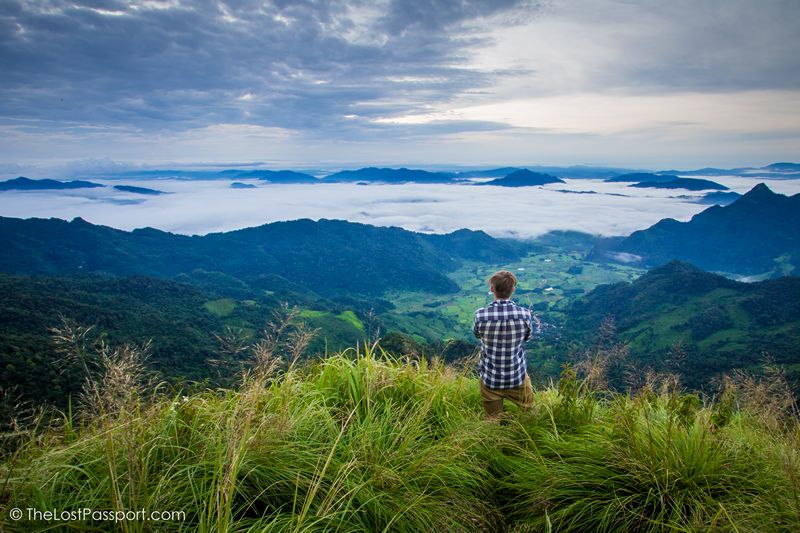
The 1-kilometer hike to the peak of Phu Chi Fa is best done early in the morning (around 5am) so you can watch the sunrise from the top. Afterward, you can explore the small hiking trails on the mountain ridge which let you wander along the Thai-Laos border a little farther. You will get a great view of the valley all the way along. Just follow the small dirt trails.
The area surrounding Phu Chi Fa is filled with winding mountain roads, hill tribes, and waterfalls. Check out my guest article Standing Above the Clouds at Phu Chi Fah.
Phu Chi Fa is a 2 to 2.5hr drive from Chiang Rai. If you want to make a one day trip you will have to leave Chiang Rai by about 3am, latest. To see the sunrise at Phu Chi Fa, I recommend you spend a night or two in the village.
Doi Pha Tang
Doi Pha Tang is located 30km north of Phu Chi Fa, nearby the small ethnic Chinese settlement called Ban Pha Tang. Be sure to stop by Ban Pha Tang on your way to try out the delicacy – stewed pork and steamed buns. The local restaurant offers a fantastic view of the mountains.
The road from Ban Pha Tang to the peak of Doi Pha Tang is a steep 1km ascent via a badly potholed road. It is another 1km hike from the car park to the top of Doi Pha Tang where the peak sits at an altitude of 1,909m. The peak of Doi Pha Tang offers a stunning 360-degree view of Laos and Thailand divided by the Mekong River.
This is another opportunity to do some hiking in Chiang Rai, with small trails following the mountain ridge. These trails offer a scenic view all the way along, I highly suggest you spend a few hours up here. You can also take a tent up Doi Pha Tang and camp up on the summit, which is by far one of the best things to do in Chiang Rai.
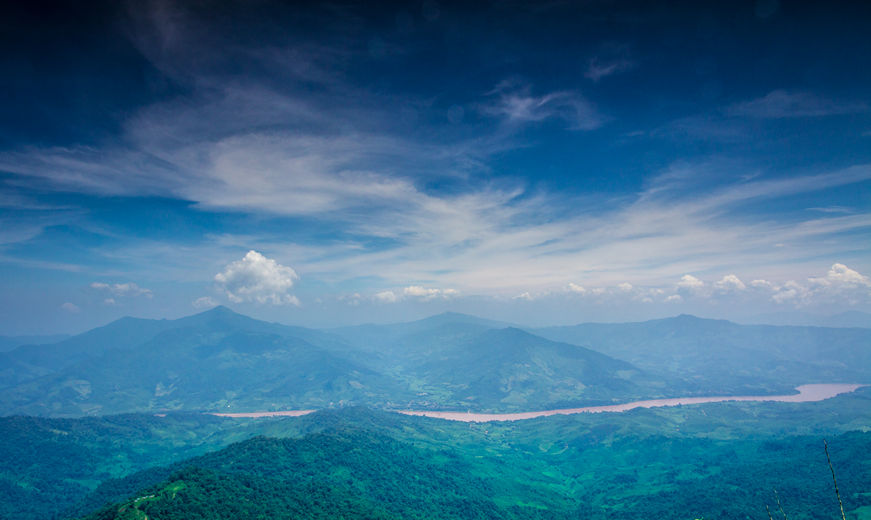
Doi Mae Salong
Doi Mae Salong is located in northwestern Chiang Rai and just 6km from Myanmar. The peak at an elevation of 1,367m is accessed via a very steep road. The area around Doi Mae Salong is home to many ethnic villages, tea, fruit and coffee plantations, having a similar feel to Doi Inthanon with less tourists.
The most popular time to visit Doi Mae Salong is between December and January when flowers bloom all over the mountain. Doi Mae Salong is best reached by spending a night in the village of Tha Ton from where you can take songtaew in the early morning.
Doi Tung
Doi Tung is another mountain in Chiang Rai located to the north of the province. by the Myanmar border. There are ethnic villages and tea plantations around the area to explore. Doi Tung is best visited on a day trip up to the Mae Sai Tachiliek border gate.
Chiang Rai Hot Springs
Thailand is hot, but in the winter, Chiang Rai is in a place of its own. As the air temperature drops to freezing one of the best things to do in Chiang Rai is to soak away in a natural hot spring.
Here is a selection of hot springs in Chiang Rai to keep you warm in the north of Thailand all winter long.
Many of the Chiang Rai hot springs can be difficult to get to, and drivers may even refuse to go to those which are further out. I’ve provided the location for each hot spring below so you can get there yourself with a bit of effort. Otherwise, send me an inquiry and I can help to arrange the transport for you.
Secret Hot Spring
This is no doubt my favorite hot spring in Thailand. This naturally heated lake set high up in the mountains is how nature invented the infinity pool. The view looking out over the mountains is incredible with a deep drop off into the valley below.
The road to get here is long, windy, and poorly signposted. You will pass small villages and rice fields along the way, before reaching a national park entry. The entry fee to this secret hot spring is 200 THB for foreigners (about USD 8) but totally worth it. You can get all the details of this amazing hot spring in my detailed Chiang Rai travel guide.

Pong Phrabat Hot Spring
The Pong Phrabat Hot Spring is the closest hot spring to Chiang Rai. It is located just 11km north of town. The water is naturally heated however the Pong Phrabat hot spring is concreted and tiled. Don’t expect a scenic setting like those hot springs in the National Park.
Entry is cheap, at just 20 THB per person and is hardly visited by foreign tourists. A trip to the Pong Phrabat hot spring is best combined with a day trip to the Pong Phrabat Waterfall.
Huay Mak Lium Hot Spring
The Huay Mak Lium Hot Spring is located along the Kok River in the Lam Nam Kok National Park, about 24km north-west of Chiang Rai. This is one of the nicest hot springs in Chiang Rai. The hot spring is set in a relaxing forest setting. The water temperature is super hot 65 degrees Celcius, unsuitable for swimming but good for boiling eggs.
The best way to get to the Huau Mak Lium hot spring is by hiring a motorbike or 4WD. It is also possible to take a longtail boat upriver from the Chiang Rai pier located by the Mae Fah Luang Bridge.
Pong Phra Soet Hot Spring
The Pong Phra Soet Hot Spring is also located in the Lam Nam Kok National Park. It is only 1km away from the Huay Mak Lium Hot Spring and is in a similar natural forest surrounding by the Kok River. There is a large outdoor pool for the general public and 8 private spa rooms which can be reserved.
Fang Hot Spring
This Chiang Rai attraction is situated in the Doi Pha Hom Pok National Park about 2 hours drive from the city. There is a natural geyser by the park entrance which erupts every 10 minutes or so up to a height of 50 meters.
There are a set of private hot spring houses within walking distance of the geyser. These houses contain naturally heated baths and are some of the best hot springs in northern Thailand.
Note: Fang district is actually in the northeastern corner of Chiang Mai province. However, it is easier to visit the Fang Hot Spring from Chiang Rai. It is a must-visit destination so I couldn’t leave it out.

Towns Around Chiang Rai Province
Chiang Rai is just one of many towns in Thailand’s northernmost province. As you can tell by the length of this article, there is plenty more to see. If you want to see what the rest of Chiang Rai province looks like then I suggest visiting at least one of the following three towns. Each has its own unique attractions.
With one week to spend in Chiang Rai, you may as well visit all of the following towns. Let me know which was your favourite!
Chiang Kong
Chiang Kong is a sleepy little town situated along the Mekong River. The main attraction here is to stay at a riverside guesthouse. From here you can enjoy the river view with a Laotian mountain backdrop.
Another thing to watch out for in Chiang Kong is the early morning procession of monks. Much like in Luang Prabang, the monks walk the streets at around 6am to fill the alms with food offerings. It is a cultural experience not to be missed.
I highly suggest staying a night at the Fortune River View (Chiang Kong). It is incredibly cheap for a luxury hotel and offers a great view of the Mekong River. It is actually one of my Top 8 Hotels in Thailand!
Discount Bookings: Fortune River View – Chiang Kong

Chiang Saen
Chiang Saen is another border town located 50km north of Chiang Kong. Chiang Saen contains a city of ancient temples dating right back to 1325. That is well before the Ayutthaya period. I’ve written more about Chiang Saen in my guest article on the top attractions in the north of Thailand.
Chiang Saen is also where you will find the Golden Triangle. This is the point where Thailand, Laos, and Myanmar meet. The countries are divided by the Mekong and Ruak rivers. The Golden Triangle is really nothing more than a quick photo stop and an iced coffee.
I suggest spending your time in Chiang Saen exploring the ancient temples. A few notable temples in Chiang Saen are; Wat Pa Sak, Wat Phra That Chedi Luang, Wat Roi Ko, and Wat Phra Buat. All are located within Chiang Saen’s Old City precinct and are within walking distance of each other.
These old temples in Chiang Saen give it a similar feeling to the ancient city of Ayutthaya and Sukhothai.

Mae Sai
Mae Sai is located 60km north of Chiang Rai. It is the main Thai-Myanmar border in northern Thailand. In the past, Mai Sai was a popular crossing point for “border runs” a quick and cheap way to extend tourist visas for an additional 14 days.
These days the Myanmar border market in Tachilek is the main attraction. Here you can find a wide range of knock-off goods, terrible cigarettes, and questionable Burmese whiskey. Most people only cross the border to Tachilek for a couple of hours, but it is also possible to stay a night of two in a hotel near the market.

Hotels in Chiang Rai
There are plenty of hotels in Chiang Rai from budget to luxury. Here are a few of my favorite places to stay:
Budget: Mercy Hostel (dorms from USD 10 per night) is located just 500 meters from the center of town, an easy walking distance from the Clocktower. You will love the pool table and common area.
Mid-Range: Laluna Resort (rooms from USD 50 per night) is located 2km south of town, a short walk from the weekend walking street market. You will love the huge pool and comfy rooms here.
For 9 great hotel options (budget to luxury), check out my article on the top hotels in Chiang Rai.
As you can see, there are so many things to do in Chiang Rai. One day you can be exploring waterfalls and mountains the next you will be relaxing in a soothing hot spring.
Of course, check out the beautiful White Temple and Black House, but please, get further out of town and explore the province too!
Don’t find out what you’ve missed when it’s too late. If you are already in Chiang Rai or planning to visit, then I guarantee you will find my Chiang Rai travel guide super useful. You may even end up staying longer than expected too!
Explore Chiang Rai like a local.
Discover incredible landscapes and waterfalls.
Experience the true Northern Thai culture.
Photo credits: Wat Rong Suea Ten





